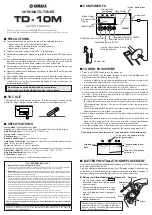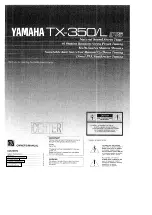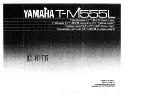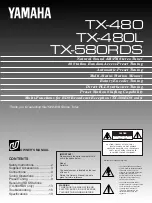
GETTING STARTED
When first turned on the Sanderson Accu-Tuner will be in the calibration mode or at the exact location where the unit
previously "timed out". The SAT checks itself for accuracy during calibration. Two to five lights may be lit and any
rotation shows the variation from A-440. The SAT will also automatically shut itself off or "time out" to conserve battery
power if not used for ten minutes. The same settings it had when it turned itself off will appear when the unit is restarted.
The SAT will be fully charged when received. The Nickel Cadmium (NiCad) battery requires charging only once to twice
weekly. This battery is tolerant of deep discharge.
LOW-BATTERY WARNING SIGNAL
A low battery warning signal will appear as "LO-BAT" in the display windows when battery energy is getting low. This
indicates that there is approximately one half hour of operating time left. If the unit continues to be used, the SAT will
automatically turn off when the battery is fully discharged. If this happens in the middle of a tuning, the SAT will continue
to operate with the battery charger plugged into an AC outlet. A fully discharged NiCad battery will take approximately 12
hours to recharge.
CALIBRATION
The 440 Hz crystal oscillator verifies calibration on the LED display when the SAT is turned on in the CAL mode. If the
display is stationary, the instrument is in perfect calibration. If the pattern is rotating, use the cents buttons to slow the
pattern down until the display rotates as slowly as possible. When you press the TUNE button the calibration setting will
be stored to memory and the display will respond to external tones rather than its internal CAL signal.
THE FOUR MODES OF OPERATION
The Sanderson Accu-Tuner has four different modes of operation:
1. The TUNE mode.
2. The MEASURE mode.
3. The FAC (stretch mode).
4. The MEMORY mode.
Each mode is entered by pressing the appropriate button or sequence of buttons on the keyboard, which is shown in
figure 2.
Fig. 2. Keyboard of the Accu-Tuner II
™
.
NOTE: For the moment, disregard the shift functions. Each will be explained below according to specific tuning
application.
1. The TUNE mode works like most conventional tuning instruments already available. Only the six white buttons in the
center of the keyboard are used, and they control the note, octave, and cents deviation to which the SAT is set. The
TUNE mode is the best place to start learning to use the SAT keyboard.
2. The MSR (measure) button puts the SAT into the MEASURE mode as long as it is held down. In this mode the
computer automatically stops the LEDs. Hold the MSR button down while the lights slow down and stop. When you
release the button the cents reading indicates the cents deviation of the unknown pitch.
3. The FAC mode uses three measurements called stretch numbers to create an excellent tuning. This tuning is a
complete 88 note stretch tuning from A0 to C8. The three stretch numbers are quick and easy to measure, they are
based on the inharmonicity of the notes F3, A4, and C6.







































